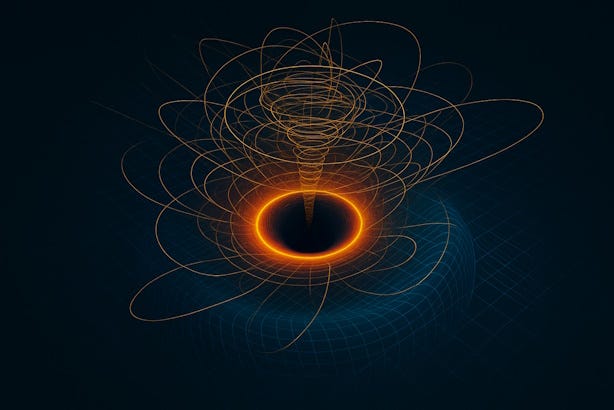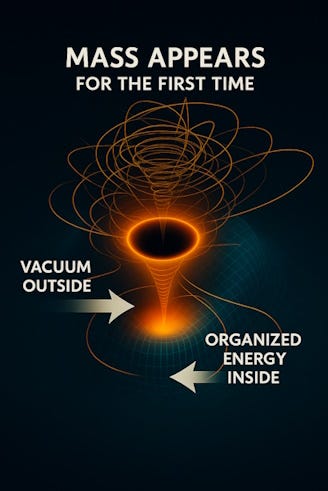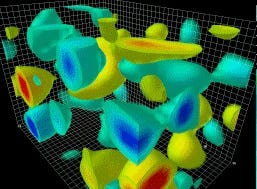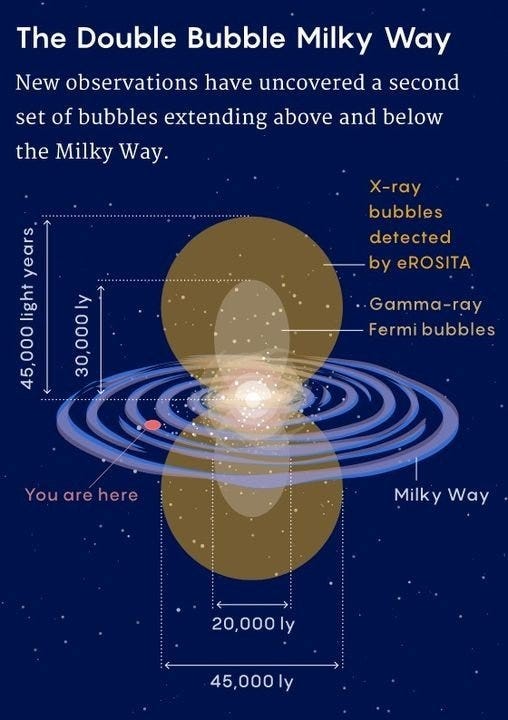
From the very first moment a proton emerged out of the quantum vacuum, the pathway to planets, stars and life was already seeded. This is not just a story of matter gathering in space, but of a single organising principle unfolding across scales — from the smallest stable structure in the universe to the birth of oceans and worlds. What follows is the journey of how a proton, a tiny vortex in the vacuum, became a planet beneath our feet.
In the very beginning, before stars, atoms or even space as we know it, there was only a sea of fluctuations — restless, silent, invisible. Physicists call this the quantum vacuum, but it is not empty. It trembles with possibility, full of tiny fields rising and falling, appearing and fading before they can ever become matter. From this neutral field, without shape or form, the first structure emerges: the proton.
This article traces the quiet unfolding of the universe — from the smallest unit of mass to the birth of worlds like our own. This is not a tale of explosions, but of gradual organisation. It is a story of how the vacuum learns to hold shape, how shape becomes gravity, how gravity gathers stars, and how from stars, planets like Earth are born.
1. Quantum Vacuum and the Birth of the Proton
Before there is matter, there is fluctuation. The quantum vacuum is a trembling field of uncertainty — particle-antiparticle pairs appearing and vanishing too quickly to be seen. In this field, nothing is truly still. It is a balanced ocean of energy, flat in geometry, containing no gravity, no curvature — only potential.

A proton is the first stable imprint on this canvas. Not a solid thing, but a tiny region where vacuum fluctuations stop cancelling out and begin to organise. Instead of dissolving back into nothing, the fluctuations fold inward, like water spiralling into a drain. In modern physics, this is sometimes described as a miniature black hole — so small it cannot collapse into destruction, or appear and disappear, but dense enough to hold form.
Press enter or click to view image in full size

Here, mass appears for the first time — not as a property, but as an effect. Mass is simply the pressure difference between the vacuum outside and the organised energy within. The universe has taken its first breath of structure.
First, picture the vacuum not as blankness but as a restless ocean of micro‑eddies — quantum vacuum fluctuations. Nothing here sits still. Tiny quanta crest and vanish in femtoseconds, like ripples that never become waves. In this neutral sea, there is no gravity, no direction, only equilibrium. What breaks the symmetry is organisation.

Now narrow your focus to a point where those fluctuations synchronise, as if a thousand tiny ripples met in phase. The field stops being merely busy and becomes coherent. In Haramein’s language, this coherence deepens until the point satisfies the black‑hole condition for its scale: a micro‑well in the vacuum, the proton as a miniature black hole. It is not a collapsed star; it is a standing vortex, a stable sink for vacuum flow at femtometer dimensions. This is the first creation — a place where the vacuum’s energy is captured and recycled fast enough to persist.
What, then, is mass here? Do not think of mass as a lump added from the outside. Think of a pressure difference. Outside the proton, the vacuum pressure is slightly higher than inside the coherent well. The result is a continuous inward flow, like water pressing toward a drain. Confinement plus flow produces an effective mass density. Mass appears because the vacuum’s jitter is being held in a pattern. In this view, mass is organised vacuum energy.
The moment mass appears, geometry answers. Spacetime around the well deforms, dimpling toward the centre. Gravity is the name we give to that deformation and to the inward current that sustains it. Nothing needs to pull; curvature and flow are the same story told two ways. A free particle simply follows the easiest path through the dimple — what Einstein called a geodesic. Thus, a proton is not only a unit of mass but a unit of curvature.
Hold that picture and scale it outward by many orders of magnitude. A universe rich with such wells — protons — cannot remain evenly spread. The tiny curvatures superpose and, over time, the neutral sea begins to gather itself. Protons pair with electrons to make hydrogen; countless hydrogens form wisps of gas; wisps become clouds. Gravity is weak in a single proton, but across light‑years it is patient and decisive.
As clouds grow denser, they cool and fragment, then collapse. In the collapse, pressure and temperature rise until hydrogen nuclei fuse. A star is born. Fusion is the second great organiser: it cooks the simplest units into heavier ones — helium, carbon, oxygen, silicon, iron — each forged in the star’s core where heat and density overcome repulsion. When massive stars die, they explode, returning their newly minted elements to space at enormous speeds, seeding the next clouds with rock‑forming matter.
Around young stars, the enriched dust and gas flatten into a thin rotating disk. Inside the disk, the same logic repeats: tiny grains stick, grow into pebbles, then boulders, then mountain‑sized planetesimals. Collisions are frequent, but not chaotic; each impact sheds heat and momentum, allowing larger bodies to keep what they collect. In time, gravity rounds the largest clumps into protoplanets. Some remain rocky and close to the heat; others accrete thick atmospheres and become giants. Our Earth grew within such a disk, assembled from elements forged in earlier stars and bound by the same curvature that first appeared around a proton.

If you replay the film in reverse, everything returns to the same principle. Planets come from disks, disks from stellar births, stellar births from collapsing hydrogen, hydrogen from protons and electrons, and a proton from coherence in the vacuum. At each step, the universe does not add substance from elsewhere; it organises what is already present. The vacuum becomes mass by patterning; mass becomes gravity by curvature; gravity becomes structure by persistence. Organisation, not addition, is the motor of creation.
A few practical images help the mind hold this:
• Quantum vacuum fluctuations: imagine a 3‑D mist of flickers, like bioluminescent plankton in a dark sea, flashing on and off with no net drift. • Proton formation: those flickers lock phase into a tiny whirlpool — an energy well at the femtometer scale — where inflow equals outflow, so the pattern endures. • Mass: feel the slight pressure difference between the restless outside and the ordered inside; the pattern’s persistence is what we measure as mass. • Gravity: watch the grid around the well relax into a dimple; nearby paths bend toward it without any rope or hook. • Cosmic structure: replicate the dimple trillions upon trillions of times; small bends add to larger valleys; rivers of hydrogen roll downhill into stars; stars fuse elements; their ashes settle into worlds.
Seen this way, the proton is not an isolated curiosity but the seed‑logic of the cosmos. It is the first successful negotiation between the vacuum’s infinite potential and the universe’s desire for lasting form. From that negotiation, everything else proceeds: clouds, stars, disks, planets — and at last the thin film of oceans and air where awareness can ask how it all began.
From Planet to Life
By the time a planet like Earth emerges, the universe has already rehearsed billions of years of transformation. Yet the story does not pause at the rock and atmosphere. The same organising principle that drew vacuum into a proton, hydrogen into stars, and dust into planets continues here — more subtle, slower, but no less exact. Now the stage is planetary, and the actors are water, carbon, atmosphere, light, and time.
Where does life begin? Not in chaos, but in gradients. Life requires imbalance — heat against cold, light against dark, ocean against crust. A young rocky planet spins beneath a star, bathed unevenly by radiation. Some regions scorch; others freeze. Between them arises flow — winds, tides, currents. Energy moves. And wherever energy moves across a difference, work becomes possible.
Consider Earth in its earliest stable form. Heavy elements like iron and nickel, forged in supernovae long before the Sun existed, have sunk to form a molten core. That core spins, generating a magnetic field — a shield against solar wind. Above it sits a mantle in slow convection, and above that, a fresh crust. Volcanoes exhale water vapor, carbon dioxide, nitrogen, sulfur. Comets and asteroids deliver more water and organic molecules. The sky thickens with steam and greenhouse gases. Rain falls for the first time.
Rain does not just wet the surface — it shapes it. It fills basins, dissolves minerals, and carries them to sea. Rivers form, carving paths that become channels for future life. In shallow oceans, a quiet miracle unfolds: water remains liquid. Liquid water is the universe’s great mediator — it softens extremes, dissolves solids, transports ions, stores heat, and allows molecules to meet and react without shattering. In liquid water, complexity does not simply survive — it accumulates.
Now imagine the ocean not as a vast, uniform soup, but as a mosaic of micro-environments. Deep-sea vents spew mineral-rich heat into cold water, creating colossal differences in temperature and chemistry. Sunlit shallows warm during the day and cool at night, concentrating and diluting salts in rhythm. Clays and mineral surfaces act as natural laboratories, holding molecules in place long enough for patterns to form. Carbon, oxygen, nitrogen, hydrogen, sulfur, phosphorus — ashes of dead stars — begin to assemble into chains.
These chains wriggle, fold, and attract other molecules. Some store energy, some catalyse reactions, some form membranes around themselves. None of this happens all at once, or by design. Like the proton, life does not arrive fully formed; it stabilises as a pattern first. It is not a thing — it is a dynamic arrangement of flow, energy, and boundary. The first cells are not inventions but solutions: membranes that hold water inside, keep chaos out, and allow just enough exchange to survive.
Why here? Why Earth? Because Earth offered three gifts rarely found together: liquid water, stable sunlight, and time. Its orbit is neither too close nor too far from the star that warms it. Its rotation creates cycles of light and dark, heat and cool — tempo for chemistry. Its size is large enough to hold an atmosphere but not so large as to crush its crust. Its magnetic shield deflects harmful radiation but lets light through. Its Moon stabilises its tilt, making seasons gentle rather than catastrophic. It is not perfect — but it is stable enough for the pattern to deepen.
In time, the chemistry learns to copy itself. Molecules become information. Information becomes memory. Memory becomes evolution. Cells learn to use sunlight directly — photosynthesis — releasing oxygen into the air. The sky, once orange and toxic, turns blue. Oxygen reacts with everything; it burns iron into rust, fuels metabolism, and makes complex life possible. The planet, once a ball of rock and fire, becomes a biosphere — stone, water, air, and life woven into one continuous process.
And still, the thread remains the same: the universe organises its own potential. The vacuum organises into mass. Mass organises into gravity. Gravity organises matter into stars and worlds. Worlds organise energy into chemistry. Chemistry organises into life. Life organises into awareness. The pattern does not break; it refines. Each step is built upon the last, but none are separate. To understand a leaf, one must understand the star; to understand the star, one must understand the proton. And to understand the proton, one must listen to the quiet trembling of the vacuum itself.
Earth, in its early form, was not yet the blue world of oceans and clouds. It was molten, unshielded, bombarded by asteroids, with volcanoes breathing gases into a forming sky. But even in this chaos, order was quietly setting its conditions. The planet cooled. A crust formed. Steam from countless eruptions condensed into clouds and fell back as rain — not for a day or a year, but for millions of years. Slowly, depressions in the crust filled with water. Oceans — a planetary mirror — appeared.
Water is not just a solvent; it is an organiser. It dissolves minerals, moves heat, transports ions, and softens the rigid into the possible. It allows atoms to drift, meet, and bind — not by force, but by opportunity. Underwater, near volcanic vents, minerals rich in iron, sulfur, and carbon formed honeycomb-like structures. These porous rocks behaved like natural laboratories, concentrating molecules, cycling heat, and providing gradients in temperature and chemistry — exactly the kind of gradients that make complexity more likely than randomness.
The Earth also developed a magnetic field as its iron core rotated. This field bent solar winds and cosmic particles away, preventing the atmosphere from being stripped. That atmosphere — mostly hydrogen, methane, ammonia, nitrogen, carbon dioxide, and water vapour — interacted with lightning and ultraviolet light to form more complex molecules: amino acids, lipids, and simple sugars. These did not appear as isolated miracles, but as repetitive patterns. Wherever energy met chemistry under stable cycles, matter learned to remember its shape.
In shallow pools, tides driven by the Moon’s pull repeatedly concentrated and dried these primitive molecules. Fatty acids aligned into tiny spheres — protocells — because water pushed them into that shape. Inside some of these spheres, strands formed — chains of nucleotides capable of storing order. These were not yet alive, but they could copy parts of themselves, sometimes with small errors. Error is not failure; it is evolution’s opening.
With time, some of these molecular assemblies achieved a loop: they could use energy from their surroundings to repair themselves, grow, and divide. This was the first metabolism. Life did not begin as competition; it began as persistence. To persist in a universe of change is to become a pattern that can remake itself.
This pattern — life — did not break from cosmic law. It extended it. Just as a proton organises the vacuum into mass, life organises matter into memory. It holds form against the pull of entropy by continuously inviting energy in, using it not to stay still but to stay becoming.
From there, the river of time widened — cells learned to photosynthesise, releasing oxygen and transforming the atmosphere; continents drifted; ecosystems formed; perception emerged; and eventually matter began to ask about its origins through the brain of a human being.
Seen in this way, life is not an interruption in the universe; it is its continuation. It is the vacuum learning to see through the eye of a creature on a small blue planet that was once a cloud of hydrogen, once a proton, once a fluctuation in a silent sea.
Oceans did not arrive in silence. They arrived with lightning, meteor impacts, volcanic gases and ultraviolet light striking the young atmosphere. Carbon dioxide, water vapour, methane and nitrogen swirled together under heat and electric storms. In this restless chemistry, simple molecules linked into more complex ones — amino acids, nucleotides, sugars. Not all survived; most broke apart. But a few, protected in shallow pools, clay surfaces or deep‑sea vents, endured long enough to meet others and try again. Life did not appear in a single spark; it accumulated through repetition.
Hydrothermal vents on the ocean floor offered a quieter stage. Here, superheated water rich in minerals met cold seawater. Iron, sulfur, and trace metals formed natural chimneys — porous, honeycombed structures. Inside their micro‑chambers, gradients of heat and chemistry mimicked the proton gradients that power cells today. Warm alkaline fluids flowed through, carrying carbon molecules. These molecules encountered surfaces that held them in place instead of letting them drift apart. Structure preceded function. Pores became reactors.
From this patient assembly, molecules began to cycle rather than scatter. Fatty acids clustered into spheres — primitive membranes. Within these spheres, chemical reactions could occur in isolation, protected from the vastness outside. Some configurations were reproduced imperfectly. Others fell apart. Time, as always, kept only what could persist. This is not separate from physics; it is physics becoming memory.
What we later called a cell was, at first, only a boundary holding pattern — a bubble that could harvest energy, maintain internal chemistry, and repair itself. Protons flowed across its thin membrane, driving the first metabolic cycles, echoing the ancient vacuum flow into the first proton. The same principle repeated on a new scale: a difference in pressure, a gradient, a flow harnessed to build and sustain order from the surrounding chaos.
From here, biology unfolds not as an exception to cosmic evolution, but as its continuation. Molecules become networks. Networks become protocells. Protocells become bacteria whose descendants will one day breathe oxygen, build coral reefs, and think. But the thread is unbroken. The logic remains: fluctuation to pattern, pattern to structure, structure to persistence. The vacuum organises into mass; mass curves into gravity; gravity gathers into stars; stars forge elements; elements collect into planets; planets host water; water becomes life; life begins to know itself. Each step is the universe folding into greater complexity to hold the same silent origin at its core.

Conclusion

From the smallest whirl in the vacuum to the first cell dividing in an ancient sea, the universe never changed its method — only its scale. A proton held the vacuum in pattern; a planet held fire and water in balance; a cell held memory and boundary within a thin film of chemistry. What began as a single vibration folded into form became the architecture of stars, the cradle of oceans, the quiet pulse of life.
From the proton to the planet, from the cell to the stars, the architecture remains the same — only the canvas widens. The same pattern that shapes a proton, a tiny well in the quantum vacuum drawing energy into a spinning vortex, appears again in galaxies, in magnetic fields, in the very structure of the cosmos. This is the holographic principle made visible: information is stored on the boundary, while flow moves through the centre in a double-torus rhythm — falling inward, rising outward, never static. The proton is the smallest stable expression of this geometry; the universe is the largest — The Holographic Principle.
Matter did not arrive from elsewhere — it learned to organise itself. Vacuum into mass. Mass into gravity. Gravity into stars. Stars into worlds. Worlds into life. And life, eventually, into awareness that can look back and recognise the pattern. To understand a single proton is to glimpse the blueprint of the whole. From silence, form can rise; from stillness, motion; and from the invisible, everything that can one day ask — “How did it begin?”
